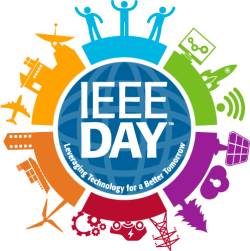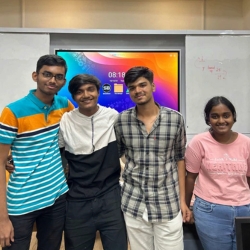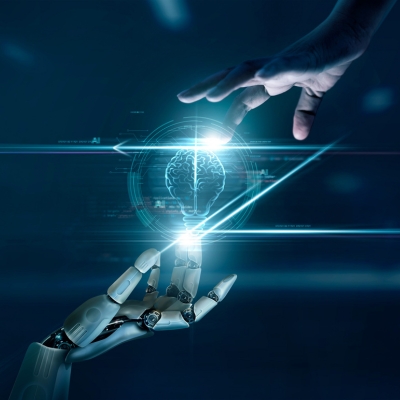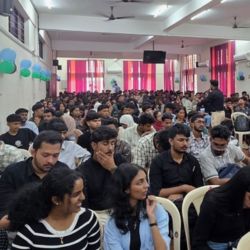Interdisciplinary Computing and Education for Real-World Solutions
 An Interview with Prof. Vipin Kumar – 2025 Taylor L. Booth Education Award Recipient
An Interview with Prof. Vipin Kumar – 2025 Taylor L. Booth Education Award Recipient
Prof. Vipin Kumar, a Regents Professor at the University of Minnesota, has wide-ranging research interests, which touch on several fields that have significant impact worldwide. His leadership as an educator in computer science and his authorship of foundational textbooks have shaped data mining and parallel computing curricula internationally. Below is an in-depth interview on the technologies he has had a hand in developing and how currently developing technology can help to solve world crises.
The isoefficiency metric you’ve developed is fundamental in evaluating parallel algorithms. How was this concept developed, and how has it evolved with the advent of modern computing architectures?
When we introduced the isoefficiency metric in the late 1980s, our goal was to provide a simple but powerful way to reason about scalability. Specifically, we wanted to answer the question: How much must the problem size grow as more processors are added in order to maintain constant efficiency? Efficiency here refers to the ratio of speedup obtained to the number of processors used.
It was already well understood that for a fixed task, the efficiency of parallel algorithm will continue to decrease as we increase the number of processors due to Amdahl’s Law: every task has some sequential component that limits scalability. Moreover, real parallel systems introduce communication overhead, which typically grows with the number of processors. These factors degrade efficiency as we increase processor count.
However, we also observed that in well-designed parallel algorithms, both the sequential fraction and the relative communication overhead tend to decrease for larger problem instances. This insight led to the isoefficiency function, which captures the rate at which the problem size must grow to keep efficiency fixed as the number of processors increases. The slower the problem size needs to grow, the better the scalability. Rather than evaluating algorithms on a fixed machine configuration, which can be misleading as systems scale, the isoefficiency framework allows us to compare algorithms based on their inherent scalability, independent of specific architectures.
The idea of the isoefficiency function actually emerged from our efforts to explain the scalability of a new parallel algorithm for state-space search that we developed in 1987. This algorithm achieved near-linear speedup on a 1,024-processor nCube system and received Honorable Mention in the 1987 Gordon Bell Award competition. From this early success, the isoefficiency framework grew into a general methodology that proved instrumental in guiding the development of truly scalable parallel algorithms. Later, it was pivotal in addressing a long-standing challenge in sparse Cholesky factorization, where existing parallel algorithms failed to scale beyond a few dozen processors. Guided by isoefficiency analysis, we restructured the algorithm to minimize communication overhead, enabling it to scale on distributed-memory systems. This work was recognized with the Outstanding Student Paper Award at Supercomputing ’94, and enabled, for the first time, factorization of million-by-million sparse matrices. The resulting algorithm became the computational core of simulation software used in automotive crash analysis, structural mechanics, and other large-scale engineering applications.
In developing a scalable Cholesky algorithm, we found that achieving good scalability required an effective partitioning of the underlying graph to reduce inter-processor communication. This realization led to the creation of METIS, a multilevel graph partitioning tool that has since found widespread use far beyond parallel computing. We later extended these ideas to develop ParMETIS, a parallel version designed through similarly rigorous scalability analysis. ParMETIS enabled massive computational simulations, including some of the largest ever performed to assess the health of the U.S. nuclear stockpile. Importantly, the principles developed for scaling matrix and graph computations also laid the groundwork for highly scalable parallel formulations of data mining algorithms, which supported the analysis of increasingly large and complex datasets in the early years of big data. More broadly, the isoefficiency analysis that guided this line of work has since also underpinned the training of large-scale deep neural networks that are central to the current AI revolution.
Over the years, isoefficiency has become a foundational concept for teaching and analyzing scalability in parallel computing, and it remains widely used in both academia and research. It is regularly included in advanced undergraduate and graduate curricula around the world, and features prominently in leading textbooks. In the classroom, students learn to derive isoefficiency functions to understand how performance scales with both problem size and processor count. Beyond education, the framework has been applied across a wide array of domains such as graph algorithms, sorting, matrix computations, data mining, scientific simulations (e.g., PDE solvers, cellular automata), and task-parallel runtime systems. Its versatility spans architectures ranging from shared-memory multicore processors to distributed-memory clusters. While the isoefficiency metric was originally introduced in the context of homogeneous parallel computing systems, its core insights remain just as relevant in today’s exa-scale and many-core environments, where real-world constraints such as contention, communication overhead, and task granularity continue to influence the overall performance.
In summary, I believe that isoefficiency has played a foundational role in shaping how we think about scalable parallelism. As systems continue to grow in scale and complexity, the need for such principled approaches to performance analysis and algorithm design is more important than ever. It is deeply gratifying to see that the ideas we introduced many decades ago are still influencing how people reason about performance, whether they’re simulating physical systems, analyzing massive graphs, or training large-scale AI models.
Tools like METIS and ParMETIS have become staples in graph partitioning. What were the key innovations that led to their widespread adoption?
The core innovation behind METIS and ParMETIS was the development of a multilevel paradigm for graph partitioning, which enabled high-quality partitions while significantly reducing both computational time and memory requirements relative to other state of the art approaches. In this formulation, nodes represent work and edges represent communication, so the goal of partitioning is to distribute the work nearly equally across processors while minimizing communication. These tools were explicitly designed to scale on large, irregular graphs, making them broadly applicable across scientific simulations, sparse matrix computations, and increasingly, in data-intensive domains.
Much of the foundational work was carried out by (then) my PhD student George Karypis, who was instrumental in formulating and implementing the multilevel schemes and continues to maintain a series of softwares that are still considered state of the art. The decision to make METIS, ParMETIS, and related tools freely available with clean APIs and comprehensive documentation significantly contributed to their adoption across research labs, industry, and academia. Their continued use today reflects not only the strength of the initial innovations but also the extensibility of the multilevel paradigm across a wide range of applications.
Several of my graduate students extended this work in pioneering directions that broadened the impact of multilevel partitioning well beyond its original applications. In the domain of high-performance computing, William Leinberger explored multi-objective graph partitioning, addressing the simultaneous optimization of competing metrics, which is an essential requirement in complex load balancing scenarios. Kirk Schloegel developed dynamic repartitioning algorithms for adaptive load balancing in time-evolving simulations, laying the foundation for scalable methods that respond to shifting computational demands in long-running scientific applications. A particularly influential contribution in this general area was the paper George Karypis and I co-authored, “Multilevel Algorithms for Multi-Constraint Graph Partitioning,” which received the SC21 Test of Time Award. This and related works have had lasting impact in enabling effective load balancing in parallel simulations involving multiple performance constraints, such as computational load, communication volume, and memory usage.
In another series of works, Rajat Aggarwal extended the multilevel paradigm to hypergraphs through the development of hMETIS. Initially created to address the challenging partitioning problems in VLSI circuit design (where it remains a state-of-the-art tool) hMETIS has also proven effective in data mining and information retrieval due to its ability to model higher-order relationships. This work also opened new directions for mining large-scale data sets that were becoming available due to the advent of the world-wide web. Sam Han applied hMETIS to document clustering, leading to the development of the Chameleon algorithm, which introduced a dynamic modeling framework for capturing both inter- and intra-cluster properties, an idea that has influenced many subsequent clustering and community detection methods. Michael Steinbach contributed to scalable clustering through bisecting k-means, which improved the efficiency and effectiveness of clustering large datasets, such as document corpora.
Collectively, these efforts extended the impact of multilevel partitioning far beyond traditional HPC. The underlying algorithmic innovations (e.g., recursive coarsening, refinement heuristics, constraint-aware optimization, and higher-order modeling) have since been adapted to address challenges in graph analytics, scientific workflow scheduling, and large-scale data mining. Together, they illustrate how a strong theoretical foundation, combined with practical insight, can drive sustained innovation across a wide range of application domains.
It is also important to acknowledge the broader ecosystem of innovation that existed when we started our research on graph partitioning back in 1994. Bruce Hendrickson made foundational contributions through his work on multilevel graph partitioning, which served as a starting point of our work. In addition, Horst Simon, Alex Pothen, John Gilbert, Padma Raghavan, Michael Heath, Rupak Biswas (and many others) played key roles in advancing graph partitioning research in the context of scientific computing and sparse matrix reordering. Collectively, these contributions helped establish graph partitioning as a standard abstraction for managing computation and data movement in parallel and distributed systems.
How do you envision the role of AI and data science in addressing some of the most pressing global challenges such as climate change and food/water/energy security?
AI and data science have a transformative role to play in addressing urgent global challenges such as climate change, food security, and sustainable water and energy systems. These are complex, interconnected problems that demand actionable insights from vast, heterogeneous data sources, ranging from satellite observations and environmental sensors to agricultural records and climate simulations. AI can help identify patterns, quantify trade-offs, and support decision-making at scales that would be impossible using traditional methods alone.
That said, traditional scientific models rooted in first principles remain essential, as they offer explanatory power and generalizability. But they are necessarily incomplete representations of real-world phenomena due to scale-accuracy trade-offs and their reliance on hard-to-calibrate parameters. Recent advances in AI offer a powerful complement: the ability to extract structure and make predictions directly from data. Yet, purely data-driven models often struggle in unfamiliar conditions and lack the transparency needed in high-stakes domains. The way forward is not to choose between these approaches, but to combine them, drawing on the strengths of both.
This integration has been a central theme of my research. Over the past two decades, I have worked to advance AI methodologies, particularly knowledge-guided machine learning (KGML), to tackle some of humanity’s most pressing challenges. KGML offers a principled framework for embedding physical laws, scientific constraints, and causal relationships into machine learning models, making them more robust, interpretable, and effective in data-sparse regimes. One example is our recent work, where we used KGML to model greenhouse gas emissions and carbon sequestration in agricultural systems. This work laid the foundation for the AI-CLIMATE Institute, a $20 million NSF/NIFA-funded institute (anchored at the University of Minnesota) that is developing MRV (monitoring, reporting, and verification) systems to support climate-smart agriculture and forestry, with the goal of reducing carbon emissions while revitalizing rural economies.
Earlier in my career, my group was among the first to use satellite data to discover relationships across the climate system and to automatically generate global land cover change histories. As PI of the $10 million NSF Expeditions in Computing project “Understanding Climate Change: A Data-Driven Approach,” I led a multi-institutional team that produced a series of influential contributions at the intersection of data science and Earth science. These included: novel methods for revealing teleconnections between different parts of the climate system, the first global dataset of ocean eddies for use by oceanographers; and the first global inventory of lake and reservoir dynamics over the past 30 years, which makes it possible to understand the impact of changing climate and human actions on surface water availability. The datasets and insights produced by this project have informed international climate assessments, including IPCC reports, and have enabled new interdisciplinary research on the impacts of climate variability and human activity on the Earth system.
Just as importantly, the scientific and technical challenges we face in applying AI to these domains are not merely barriers. They are opportunities to push the frontiers of AI itself, inspiring new methods that are more robust, transparent, and more aligned with the needs of science, policy, and society.
Mentorship is a significant aspect of your career. How do you guide students to navigate the complexities of interdisciplinary research?
I advise my students to aim for meaningful contributions over metrics, reminding them that high-impact research often comes from taking on complex, interdisciplinary challenges rather than chasing quick publications. In computer science, methodological innovation is central, but I urge students to ground those innovations in applications that matter, particularly those that benefit from interdisciplinary collaboration.
Interdisciplinary research requires patience and a collaborative mindset. I advise students to treat domain experts as equal partners, not just providers of data or problem statements. This means taking the time to learn the language of other disciplines and engaging deeply with their perspectives and methods. While such work often progresses more slowly than studies that are driven via standard benchmarks, it leads to contributions that are more enduring and impactful.
To help students navigate this path, I encourage them to join ongoing interdisciplinary projects led by senior graduate students. This gives them the opportunity to learn the ropes, contribute meaningfully, and accelerate their development. As they gain experience, they begin to lead collaborative efforts of their own and mentor younger students in turn.
Many of my most impactful interdisciplinary contributions, especially those related to environment and sustainability, have required large team efforts due to the complexity and scale of the underlying problems. In the vast majority of these projects, my students and postdocs have served as lead authors on publications in top-tier interdisciplinary journals, reflecting both their leadership and the collaborative spirit of our work. These experiences also prepare them exceptionally well for real-world careers, where working in diverse teams to address high-stakes problems is the norm.
What future directions do you foresee for machine learning and its integration with other scientific domains?
The future of machine learning lies in its deep integration with the scientific enterprise. It should not be viewed merely as a tool for prediction, but as a driver of discovery, understanding, and innovation. As scientific domains increasingly grapple with complex, data-rich, and critical scientific challenges, machine learning has the potential to transform how we formulate hypotheses, model systems, and make informed decisions.
One of the most promising directions is the continued advancement of knowledge-guided machine learning (KGML), a paradigm my group helped pioneer more than a decade ago. As I noted earlier, KGML embeds scientific knowledge into machine learning models, making them more robust, data-efficient, and better aligned with scientific understanding. Looking ahead, I see major opportunities to apply this approach to pressing environmental and sustainability challenges.
At the same time, generative AI is opening new possibilities for scientific discovery, from generating hypotheses to designing experiments and simulating complex systems. These opportunities and their challenges were the focus of the Generative AI for Science workshop that I co-organized last week (August 13-14,2025), which brought together researchers from academia, industry, and federal agencies to chart a community roadmap for this rapidly growing field. This workshop built on two earlier NSF-sponsored workshops that I co-organized in 2023 and 2024. The reports from those meetings have emphasized a common message: while many of the most visible advances in machine learning to date have been driven by progress in vision and language modeling, the next wave of breakthroughs in AI will likely come from tackling problems in a much broader set of scientific domains. In these domains, scientific knowledge has been accumulated over decades and even centuries, providing a rich foundation to guide and constrain AI methods. A central theme across all three workshops has been that AI can both advance science and, in turn, be advanced by the challenges posed by science. Together, these efforts underscore the growing momentum around charting the future of AI for Science and its role in shaping national research priorities.
Realizing this potential, whether through KGML, GenAI, or future innovations, will require deep and sustained collaboration across disciplinary boundaries. From my own experience in Earth science, ecology, hydrology, oceanography, and agriculture, I have seen that the greatest breakthroughs come when AI researchers engage fully with the perspectives of other disciplines. That is where the next wave of innovation will emerge, and where AI can deliver its most profound contributions to science and society.
Prof. Vipin Kumar’s work in parallel computing, data science, and creating interdisciplinary solutions to world problems with his students is what the 2025 Taylor L. Booth Education Award stands for: providing mentorship to and fostering inspiration in future innovators in computing.









